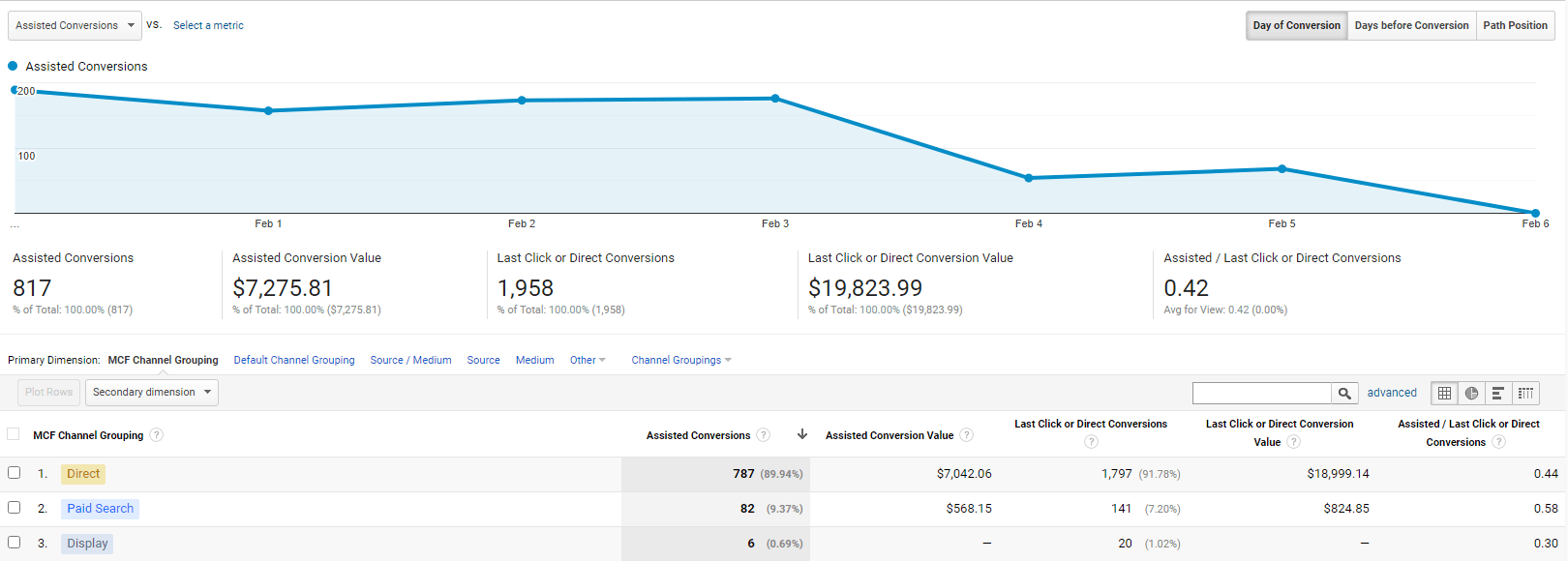-
 Published: Feb 18, 2023
Published: Feb 18, 2023
-
 6 min. read
6 min. read
-
 Matthew Gibbons
Matthew Gibbons Lead Data & Tech Writer
Lead Data & Tech Writer
- Matthew is a marketing expert focusing on the SEO & martech spaces. He has written over 500 marketing guides and video scripts for the WebFX YouTube channel. When he’s not striving to put out some fresh blog posts and articles, he’s usually fueling his Tolkien obsession or working on miscellaneous creative projects.
What are assisted conversions? Assisted conversions refer to marketing channels that help push users toward converting but aren’t the channels that give them the final push that makes them convert.
When you make a cake, the last thing you usually do is bake it in the oven. That’s what turns it into a cake. But imagine if the recipe only said, “put the cake in the oven and bake it.” That wouldn’t be a very good recipe. Baking might be the last step, but it’s not the only one. There are lots more that precede that.
It’s the same way with your marketing and sales. There might be one marketing channel that converts each of your customers, but that doesn’t mean it’s the only channel that contributes to their conversions. It may be the last one, but there are other marketing materials that come before it, and you should track them, too.
That’s where assisted conversions come in. By tracking assisted conversions, you can get much better insights into the way your marketing efforts work. But what are assisted conversions, and why are they important?
Keep reading to find out. Then subscribe to Revenue Weekly, our email newsletter, for more digital marketing tips from the experts!
Join 200,000 smart marketers and get the month’s hottest marketing news and insights delivered straight to your inbox! “*” indicates required fields (Don’t worry, we’ll never share your information!)Don’t miss our Marketing Manager Insider emails!
Enter your email below:
Inline Subscription Form – CTA 72

What are assisted conversions?
Assisted conversions are any conversions that a given channel contributed to but where that channel wasn’t the last one the users interacted with before converting.
If that definition was hard to follow, don’t worry — let’s explain a bit more. When users convert into customers, it doesn’t happen out of nowhere. Generally, it happens after they’ve viewed a series of different marketing materials — an email here, a blog post there, and maybe a paid ad right at the end.
Eventually, one specific marketing material will cause them to finally convert. But that doesn’t mean that marketing material was the only one that contributed. All the channels they interacted with had a hand in driving them toward a conversion.
Of course, the last channel gets credit for completing the conversion, but you still want to track the contributions of the earlier channels, too. So, any conversions a channel has helped to drive — without being the channel that completed the conversion — qualify as assisted conversions.
What are first, assisted, and last interactions?

You can track assisted conversions in Google Analytics. When you do, it measures them using three different types of interactions:
- First interaction: The first interaction a customer has with a marketing channel on their path to conversion.
- Last interaction: The final interaction a customer has with a marketing channel before converting.
- Assisted interaction: Any interaction a customer has with a marketing channel on the path to conversion that falls between the first one and the last one.
It’s good to keep up with interactions in this way because it helps you see which channels typically initiate conversion paths versus which ones typically close them, plus which ones commonly assist along the way.
What is assisted conversion value?
Assisted conversion value is a measurement of how many assisted conversions a given marketing channel has and how much revenue those conversions have driven. The more conversions a channel has assisted with, the higher its assisted conversion value will be. You can find this metric in Google Analytics.
Needless to say, assisted conversion value gives you an excellent metric for evaluating how good a given channel is at driving conversions. The higher the number, the more useful that channel is for contributing to conversions.
What is the assisted conversions / direct conversions ratio?
Another metric you can view in Google Ads is the assisted conversions / direct conversions ratio. This is a ratio of how many conversions a marketing channel has assisted with as compared to how many conversions it’s directly driven.
So, let’s say a channel assists with 10 conversions and directly drives 5 conversions. The ratio would then be 10/5, or 2. On the other hand, let’s say a channel assists with 3 conversions and directly drives 9. The ratio then would be 3/9, or 1/3.
As you can see from those examples, the larger the ratio is, the more it skews toward assisted conversions. The smaller the ratio, meanwhile, the more it skews toward direct conversions. A ratio of around 1 means the channel has a roughly equal number of assisted and direct conversions.
Why track assisted conversions?
Now that we’ve established what assisted conversions are and how they work, you may be wondering: Why bother to track them at all?
The answer is twofold, and we’ll cover each reason below.
1. They let you see which marketing channels are helping you drive conversions
The first reason to track assisted conversions is that they help you figure out which of your marketing channels are actually contributing to conversions.
Imagine that you spend tons of time and effort to build a killer email marketing campaign. You send out all these emails, and yet not a single one of them ever seems to make users convert. So, you start to think your email marketing isn’t accomplishing anything, and you drop the campaign altogether.
But imagine if you found out the email campaign was contributing, but it was just routinely showing up earlier in the conversion path rather than right at the end. It’s still contributing, even though it’s not directly driving conversions.
Without tracking assisted conversions, you’d never have known that, and you’d have thrown away a campaign that was actually helping you.
2. They help you figure out where channels are in the funnel
The other reason to track assisted conversions is that doing so helps you place your different marketing channels throughout the funnel.
Some marketing channels are bottom-of-funnel channels, meaning they target users at the bottom of the marketing funnel and often directly drive conversions. But others are closer to the top of the funnel, and they’re more introductory sorts of marketing materials.
By looking at something like the assisted conversions / direct conversions ratio, you can figure out where each channel falls in the funnel. If a given channel has a very small ratio, you know it’s probably a bottom-of-funnel channel. Whereas one with a large ratio is likely very top-of-funnel.
Knowing that can help you optimize your different marketing channels accordingly.
WebFX has driven the following results for clients: $6 billion 24 million 7.14 millionOur digital marketing campaigns impact the metrics that improve your bottom line.
See More Results 
![]()
In client revenue
![]()
Leads for our clients
![]()
Client phone calls
WebFX can help you drive more conversions for your business
We’ve now gone over what assisted conversions are, how they work, and why you should use them. All that’s left to do now is go start tracking them in Google Analytics.
But what if you’re struggling to drive conversions in the first place? Well, that’s an entirely different problem — but thankfully, we’ve got a solution for that, too. At WebFX, we specialize in driving conversions. With our digital marketing services, you can give your campaigns a major upgrade.
To get started with us, just give us a call at 888-601-5359 or contact us online today!
-
 Matthew is a marketing expert focusing on the SEO & martech spaces. He has written over 500 marketing guides and video scripts for the WebFX YouTube channel. When he’s not striving to put out some fresh blog posts and articles, he’s usually fueling his Tolkien obsession or working on miscellaneous creative projects.
Matthew is a marketing expert focusing on the SEO & martech spaces. He has written over 500 marketing guides and video scripts for the WebFX YouTube channel. When he’s not striving to put out some fresh blog posts and articles, he’s usually fueling his Tolkien obsession or working on miscellaneous creative projects. -

WebFX is a full-service marketing agency with 1,100+ client reviews and a 4.9-star rating on Clutch! Find out how our expert team and revenue-accelerating tech can drive results for you! Learn more
Try our free Marketing Calculator
Craft a tailored online marketing strategy! Utilize our free Internet marketing calculator for a custom plan based on your location, reach, timeframe, and budget.
Plan Your Marketing Budget

Maximize Your Marketing ROI
Claim your free eBook packed with proven strategies to boost your marketing efforts.
Get the GuideTry our free Marketing Calculator
Craft a tailored online marketing strategy! Utilize our free Internet marketing calculator for a custom plan based on your location, reach, timeframe, and budget.
Plan Your Marketing Budget





